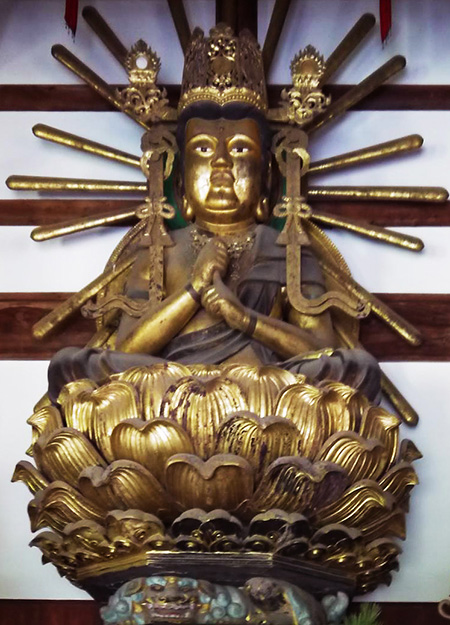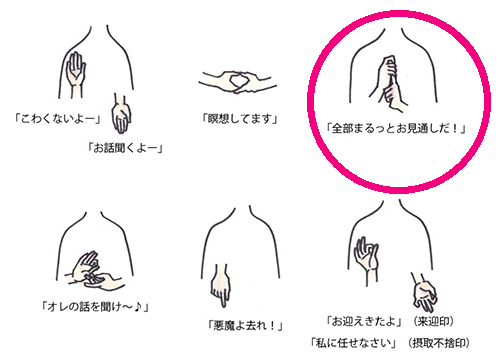

さてすっかり仏教寺院建築探訪がシリーズ化しているブログです。
神社や寺院は「古寺巡礼」好きなことから写真が多数あり再探索しながら、
住宅建築との関連で深掘りを始めたら、これはこれで興味が強くなった。
こういう建築群は参観が自由であるという要素が大きい。
基本パブリックな性格の建築というのは取材者としては稀有なのですね。
いまのシリーズ化は5年前ほどの774年頃創建の韓国・仏国寺取材記がきっかけ。
そうすると日本仏教導入時期と対比させながら国際比較もハッキリする。
自然に歴史経緯を含めてわかりやすく構成できる。
で、飛鳥寺、法隆寺、高野山金剛峯寺、そして根来寺と探索してきました。
そういう経緯なので、写真整理も同時に行って、比較対照もできたりします。
仏教というのは世界宗教なので彼我の類似性と相違両方が浮かび上がってくる。
本日は気になっていた「仏像の手のポージング」について、であります。
上の写真は韓国仏国寺の創建時の「本尊」と言われる毘蘆遮那仏。
<現在は創建時から宗派が変わって釈迦如来像になっている>
毘盧遮那仏(びるしゃなぶつ)は大乗仏教における仏。華厳経において
中心的な存在として扱われる尊格で密教においては大日如来と同一視される。
日本では奈良東大寺の大仏さんもこれなんですが、
真言密教ではまさに中核的な仏様ということで本尊として祀られることが多い。
で、下の写真は根来寺の「大日如来」像であります。
この両者の手のポージングが同じようなのに、実は左右反対なんですね。
調べてみると、日本国内での大日如来像の手のポーズは根来寺とみな同じ。
韓国仏国寺の大日如来さんだけが、どうも左右を反対に手を組まれているのです。

手のポーズ、仏さんで違うよな〜とは知りつつ、意味はまったく知らなかった。
チョット調べたら、上のような意味合いだそうでさすが大日如来像らしく
「全部まるっとお見通しだよ」という印だそうです。
しかし、どうして韓国仏国寺では左右反対なのか、
韓国仏国寺でも「ふつうとは違う手のポージング」と説明されているので
この仏国寺だけの特別のポージングということなのだそうです。
う〜〜む、なんでさ(笑)。
きっと宗教的に深〜い意味があるのでしょうが、衆生にはわかるはずもない。
でも深く謎かけされているようでドツボにハマりそうなのです(笑)。
今のところ、ナゾということでスルーしているのですが、さて?
しかし仏国寺の仏さんはどうも日本の寺の本尊たちとは違ってイメージがかわいい。

これは仏国寺のいまの本殿・大雄殿の本尊、釈迦如来像ですが、
どうも表情がマンガチックで右端の僧侶らしき人物などマンガ登場人物風。
ちなみに手のポーズは右下の「お迎えに来たよ,安心して」の印。
日本の仏像群のように威厳というような志向性を感じません。
国柄で仏教というものに対しての人々の受容態度が大きく違いがあるのか。
まぁたまたま、ということなのかどうか、興味津々であります。
English version⬇
[Buddha statue, Vairocana (Vairocana Buddha) hand pose difference between Japan and Korea]
By the way, it is a blog that is a series of Buddhist temple architecture explorations.
There are many shrines and temples because I like “old temple pilgrimage”, so while re-searching
This made me more interested when I started digging deeper in the context of residential construction.
There is a big element that such a group of buildings is free to visit.
Architecture with a basic public character is rare for an interviewer, isn’t it?
The current series was triggered by an interview with Bulguksa Temple in South Korea, which was founded around 774 about five years ago.
Then, the international comparison will be clear while comparing it with the time when Japanese Buddhism was introduced.
It can be constructed in an easy-to-understand manner, including the history of history.
So, I searched for Asuka-dera, Horyuji, Koyasan Kongobuji, and Negoroji.
That’s why I can organize photos at the same time and compare and contrast them.
Since Buddhism is a world religion, both his similarities and differences emerge.
Today, I would like to talk about “the pose of the hand of the Buddha statue” that I was interested in.
The photo above is the Bulguksa Bulguksa, which is said to be the “honzon” when the Bulguksa Temple was built.
<Currently, the sect has changed since its foundation and it has become the statue of Shaka Nyorai>
Birushanabutsu is a Buddhist buddha in Mahayana Buddhism. In Avatamsaka Sutra
It is a dignified existence that is treated as a central entity and is equated with Dainichi Nyorai in esoteric Buddhism.
In Japan, this is also the Great Buddha of Todaiji Temple in Nara.
In Shingon Esoteric Buddhism, it is often enshrined as the principal image of Buddha because it is the very core Buddha.
The photo below is the statue of “Dainichi Nyorai” at Negoroji Temple.
Although the poses of these two hands are similar, the left and right are actually opposite.
When I looked it up, the pose of the hand of the statue of Dainichi Nyorai in Japan was the same as that of Negoroji.
Only Mr. Dainichi Nyorai of Bulguksa, Korea, seems to have joined hands in the opposite direction.
I knew that the pose of the hand was different for Buddha, but I didn’t know the meaning at all.
When I looked it up, it seems that it has the above meaning, as expected, it seems to be a statue of Dainichi Nyorai.
It seems to be a sign that “everything is out of sight”.
But why is it the opposite at Bulguksa Temple in Korea?
Even at Bulguksa Temple in Korea, it is explained as “a different hand pose”.
It seems that it is a special pose only for this Bulguksa temple.
Hmmm, why (laughs).
It must have a deep religious meaning, but it cannot be understood by sentient beings.
But it seems to be a deep mystery, and I’m addicted to it (laughs).
So far, I’m through because it’s a mystery, but what?
However, the image of Bulguksa at Bulguksa is cute, unlike the principal idols of Japanese temples.
This is the statue of Shaka Nyorai, the principal image of the current main shrine of Bulguksa Temple, Daioden.
The expression is manga-like, and it looks like a manga character such as a monk-like person on the far right.
By the way, the pose of the hand is a sign of “I’m here to pick you up, feel at ease” at the bottom right.
I don’t feel the dignity of the Buddhist statues in Japan.
Is there a big difference in people’s acceptance of Buddhism in their nationality?
I’m curious whether it happens or not.
Posted on 11月 26th, 2021 by 三木 奎吾
Filed under: 住宅マーケティング, 日本社会・文化研究







コメントを投稿
「※誹謗中傷や、悪意のある書き込み、営利目的などのコメントを防ぐために、投稿された全てのコメントは一時的に保留されますのでご了承ください。」
You must be logged in to post a comment.